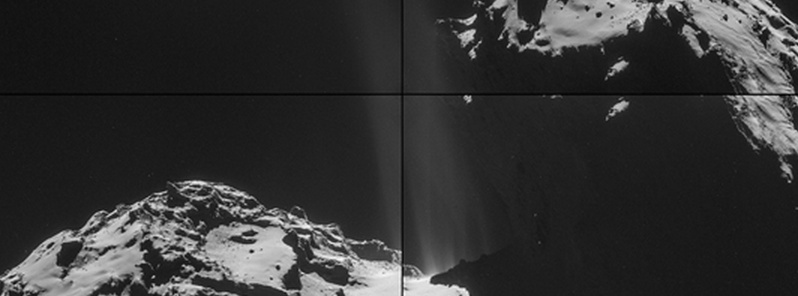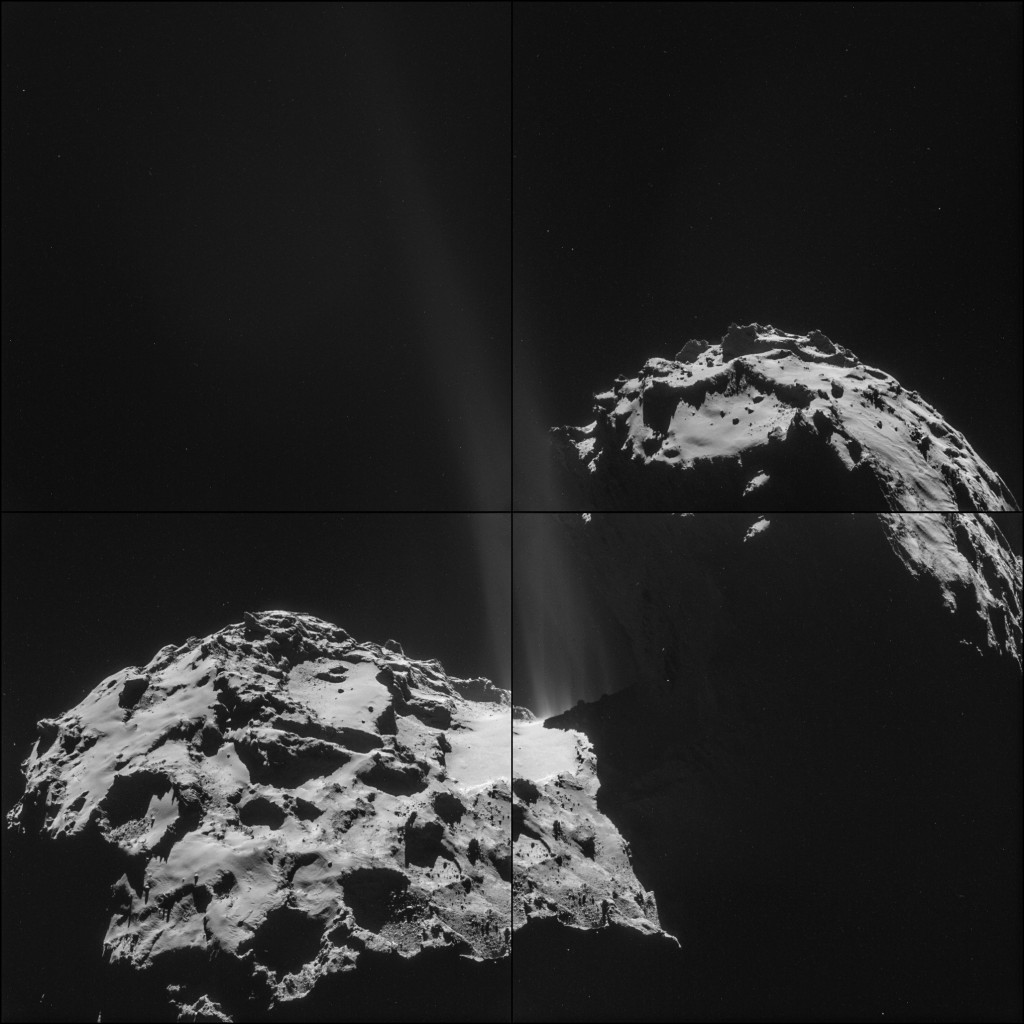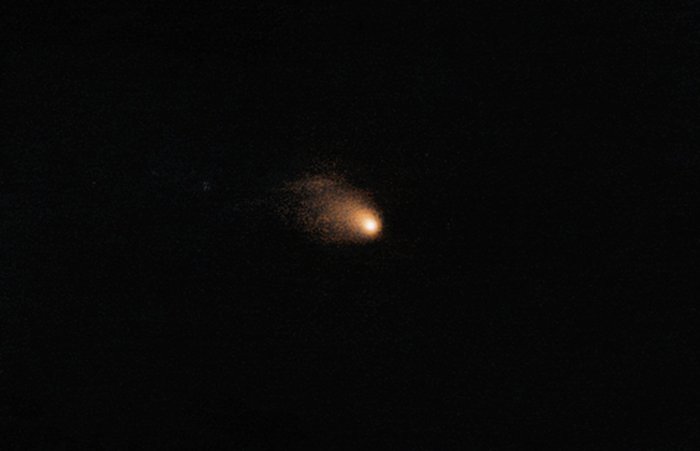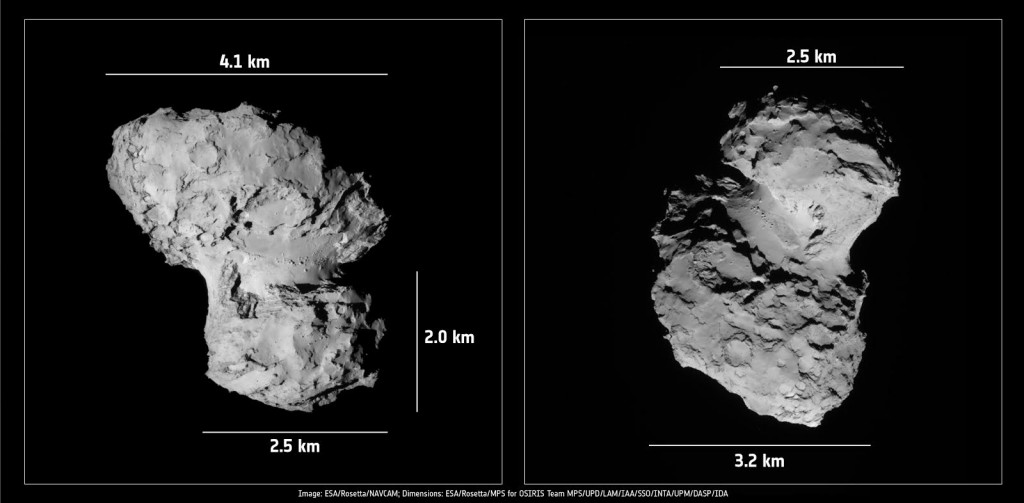Comet 67P has 19 000 km long coma and Rosetta is less than 30 km from its surface

ESA has released a montage of four images of Comet 67P/C-G taken on September 26, from a distance of 26.3 km (16 miles) from the center of the comet, showing spectacular region of activity at the neck of the comet.
What we’re seeing is the product of ices sublimating and gases escaping from inside the comet, carrying streams of dust out into space. Zooming in close to the surface and to the source of this activity and it is apparent that it is originating from several discrete locations.
It’s perhaps hard to believe looking at images like this at less than 30 km distance from the surface, but recent ground-based images have revealed that 67P/C-G’s coma already extends at least 19 000 km from the nucleus.

Four image montage of 67P/C-G on 26 September from a distance of 26.3 km. Credit: ESA/Rosetta/NAVCAM
The individual images have been background subtracted to remove some striping and fixed noise patterns. In making the montage, the background levels have then been adjusted in order to make the images more or less equivalent, the vignetting in the corners of the images has been reduced, and some processing of the overall brightness and contrast has been applied using Adobe Lightroom. Finally, the montage has been rotated by 180°.
"We have not made a proper mosaic on this occasion, because it is becoming extremely difficult at these close distances due to the combined effect of the comet rotating between the first and last images taken in the sequence (about 10 degrees over 20 minutes) and the spacecraft moving by some 1–2 km in the same time."
While the two images on the right of the montage could perhaps be joined seamlessly, the problem becomes much harder between the lower-right and lower-left images. Careful inspection makes it clear that the perspective has shifted considerably between them and that some of the shadows have changed a lot as well.
As the comet gets progressively closer to the Sun along its orbit, the surface will become warmer, and the level of activity will increase, producing a vast coma around the nucleus, along with a tail.

This image of comet 67P/C-G was taken with ESO's Very Large Telescope on 11 August 2014. It was made by stacking 40 short exposure images (each lasting 50 seconds) and then removing the background stars. The comet's coma extends at least 19,000 km from the nucleus. The central pixel includes the Rosetta spacecraft, presently at comet 67P/C-G, which is too small to be resolved in the image. The coma is asymmetric, as the dust is swept away from the Sun – located beyond the lower right corner of the image – to form the beginnings of a tail. Credit: Colin Snodgrass/ESO/ESA
Measuring Comet 67P/C-G
Following the release of the montage image ESA published a summary of some of the essential physical parameters of Comet 67P/Churyumov-Gerasimenko, as measured by Rosetta ahead of and since its August 6th rendezvous. Physical parameters measuring is an on-going process and the numbers will be updated as newer data are obtained, analyzed, and made available.
One of the key things is the so-called “shape model”, meaning a 3D model of the comet based on images from the OSIRIS and NAVCAM cameras, ESA said yesterday in the mission blog. "In a previous post we showed a render of one of the first shape models derived from OSIRIS data. Here we are releasing a more recent OSIRIS shape model in .wrl and .obj format, suitable for loading into 3D graphics applications (click the links to download)."
A render of this shape model can be seen here, while the image below shows a pair of NAVCAM images to illustrate the sizes.

Comet 67P/C-G dimensions. Images: NAVCAM (August 19th image); dimensions: OSIRIS
Because roughly 30% of the ‘dark side’ of 67P/C-G has not been resolved and analyzed fully yet, the shape model is very incomplete over those regions. As a result, some of the derived parameters for the comet are only best estimates at present. These include the volume and the global density, the latter depending on the mass and the volume.
The table below summarizes the approximate dimensions of 67P/C-G and other known parameters derived from observations made by Rosetta, with the instrument with which the measurement was made also indicated. Links are provided to earlier posts where some of these numbers have been previously presented.
Again, these values are preliminary and will likely change as the mission progresses and more data are available, and as the comet itself changes as it moves closer to the Sun. Similarly, other parameters such as the albedo of the comet will be added to this table, as they are made available by the instrument science teams.
| Dimensions (small lobe) | 2.5 x 2.5 x 2.0 km | OSIRIS |
| Dimensions (large lobe) | 4.1 x 3.2 x 1.3 km | OSIRIS |
| Rotation | 12.4043 hours | OSIRIS |
| Spin axis | Right ascension: 69 degrees; Declination: 64 degrees | OSIRIS |
| Mass | 10^13 kg | RSI |
| Volume | 25 km^3 | OSIRIS |
| Density | 0.4 g/cm^3 | RSI / OSIRIS |
| Water vapour production rate | 300 ml/sec (Jun 2014); 1–5 l/sec (Jul-Aug 2014) | MIRO |
| Surface temperature | 205–230K (Jul-Aug 2014) | VIRTIS |
| Subsurface temperature | 30–160K (Aug 2014) | MIRO |
| Gases detected | Water, carbon monoxide, carbon dioxide, ammonia, methane, methanol | ROSINA |
| Dust grains | A few tens of microns to a few hundreds of microns | COSIMA (detections also by GIADA) |
Rosetta mission 3D model
The team at Solar System Scope made another excellent 3D model showing Rosetta, its Philae lander and the comet as they travel through the Solar System.
3D model courtesy of Solar System Scope
Featured image: Four image montage of 67P/C-G on 26 September from a distance of 26.3 km. Credit: ESA/Rosetta/NAVCAM

Commenting rules and guidelines
We value the thoughts and opinions of our readers and welcome healthy discussions on our website. In order to maintain a respectful and positive community, we ask that all commenters follow these rules.